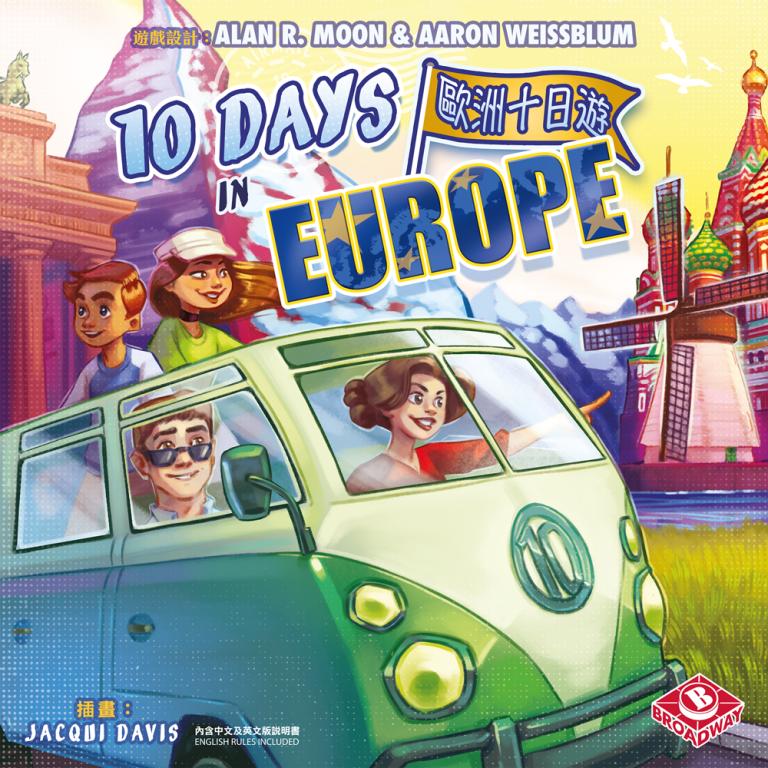10 Days in Europe

10 Days in Europe
"There is much to be discovered in Europe! Many roads lead to success in this exciting travel game - you just have to find the right one. Exchange your cards cleverly and find your way through Europe quickly to win. Ten cards must show continuous travel either by land, sea or air."
Europa Tour (copyright 2002) is possibly the first in the 10 Days in series while 10 Days in Europe is the third installment in the 10 Days in series.
Gameplay
All players pick tiles up one at a time, examining them and placing them onto any empty spot on their tile holders. Then, in turn, each player draws one tile and may replace one of their lined-up tiles with it. (Tiles may not be rearranged.) Tiles are drawn from one of the face-up discard piles or a face-down pile. The drawn card or replaced card is then discarded into one of the face-up piles. The first person to have all ten tiles satisfy the travel connection requirements wins.
Connection requirements:
By Foot If a country is next to or connected to another country on the map, their tiles may be placed side-by-side
By Air Any two countries of the same color may be connected by an airplane of that color (its tile in between them)
By Ship If two countries can be linked by ship a ship can connect them (a ship tile placed between them)
Contents:
60/7 cardboard tiles - 40/8 country tiles, 9/10 ship tiles and 5 pairs of plane tiles (in 5 colours)
4 trip planners (tile holders)
1 game board showing a map of Europe, each country depicted in one of 5 colors
Differences between Europa Tour and 10 Days in Europe
Europa Tour has 5 face-up discard piles, a board with 40 countries, 40 country tiles and 10 identical ship tiles. A ship can connect 2 countries joined by a dashed line.
10 Days in Europe has 3 face-up discard piles, a board with 42 countries, 48 country tiles (6 duplicates), 4 Atlantic, 3 Mediterranean and 2 Baltic ship tiles. If a sea or ocean borders two countries, a ship can connect them.
Europa Tour (copyright 2002) is possibly the first in the 10 Days in series while 10 Days in Europe is the third installment in the 10 Days in series.
Gameplay
All players pick tiles up one at a time, examining them and placing them onto any empty spot on their tile holders. Then, in turn, each player draws one tile and may replace one of their lined-up tiles with it. (Tiles may not be rearranged.) Tiles are drawn from one of the face-up discard piles or a face-down pile. The drawn card or replaced card is then discarded into one of the face-up piles. The first person to have all ten tiles satisfy the travel connection requirements wins.
Connection requirements:
By Foot If a country is next to or connected to another country on the map, their tiles may be placed side-by-side
By Air Any two countries of the same color may be connected by an airplane of that color (its tile in between them)
By Ship If two countries can be linked by ship a ship can connect them (a ship tile placed between them)
Contents:
60/7 cardboard tiles - 40/8 country tiles, 9/10 ship tiles and 5 pairs of plane tiles (in 5 colours)
4 trip planners (tile holders)
1 game board showing a map of Europe, each country depicted in one of 5 colors
Differences between Europa Tour and 10 Days in Europe
Europa Tour has 5 face-up discard piles, a board with 40 countries, 40 country tiles and 10 identical ship tiles. A ship can connect 2 countries joined by a dashed line.
10 Days in Europe has 3 face-up discard piles, a board with 42 countries, 48 country tiles (6 duplicates), 4 Atlantic, 3 Mediterranean and 2 Baltic ship tiles. If a sea or ocean borders two countries, a ship can connect them.
Player Count
2
-
4
Playing Time
20
-
30
Age
10
Year Released
2002
Newest Review
Remote video URL
